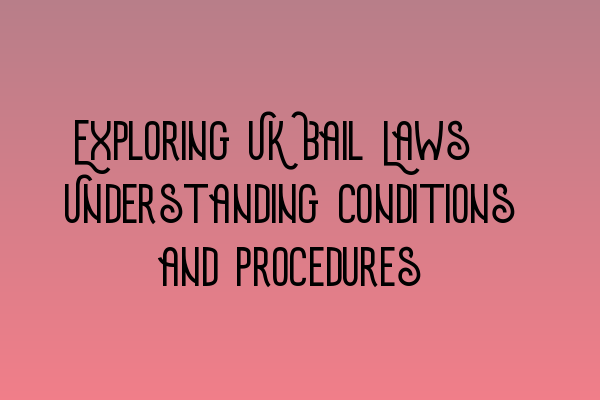Exploring UK Bail Laws: Understanding Conditions and Procedures
Welcome to the SQE Criminal Law & Practice Law UK blog. In this article, we will delve into the intricacies of UK bail laws, including the conditions and procedures involved. Bail is an integral part of the criminal justice system, providing individuals with the opportunity to be released from custody pending their trial. It is important to understand the requirements and obligations associated with bail, as well as the potential consequences of non-compliance.
What is Bail?
In the UK legal system, bail refers to the temporary release of an individual who has been charged with a crime, pending their trial or court appearance. The granting of bail is largely based on the principle of presumption of innocence, which ensures that individuals are not unnecessarily detained before being proven guilty. However, bail is not an automatic right and can be denied if there are substantial grounds for believing that the accused will fail to appear in court, commit further offenses, interfere with witnesses, or obstruct justice.
Bail Conditions and Procedure
Bail conditions are the restrictions imposed on an individual while they are on bail. These conditions vary depending on the circumstances of the case and can include:
- Regular reporting to a police station
- Surrendering travel documents
- Refraining from contacting certain individuals
- Electronic monitoring
- Curfews
The purpose of bail conditions is to ensure that the accused complies with the terms set by the court and does not pose a risk to public safety or interfere with the administration of justice. Failure to comply with bail conditions can result in the revocation of bail and the individual being returned to custody.
The procedure for obtaining bail in the UK involves several steps:
- Arrest and initial detention: When a person is arrested, they may be held in police custody for questioning. The police will then decide whether to release the individual on bail or keep them in custody.
- Initial court appearance: If the decision is made to keep the individual in custody, they must be brought before a court within 24 hours of their arrest for an initial court appearance. At this stage, the court will consider bail options.
- Bail hearing: If the court decides that bail is appropriate, a bail hearing will be scheduled. During the bail hearing, the court will consider factors such as the seriousness of the offense, the likelihood of the accused fleeing, and the potential risk posed by granting bail.
- Bail conditions: If the court grants bail, they will impose conditions on the individual. These conditions must be adhered to until the conclusion of the case.
It is important to seek legal advice from a qualified solicitor to navigate the complexities of the bail process and ensure the best possible outcome.
Conclusion
Bail is a crucial aspect of the UK criminal justice system, allowing individuals to be released from custody pending their trial. Understanding the conditions and procedures involved is essential for both defendants and their legal representatives. If you require further information about UK bail laws or need assistance with a criminal case, our team at SQE Criminal Law & Practice Law UK is here to help.
For more related articles, please check out:
- Demystifying the Solicitors Qualifying Examination Format
- LLC Formation Made Simple: Step-by-Step Guide for UK Entrepreneurs
- LLC Formation: A Step-by-Step Guide for UK Entrepreneurs
- Business Regulations in the UK: A Comprehensive Overview
- Ethical Considerations in UK Law: Upholding Professional Standards
